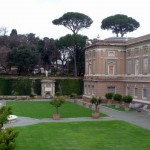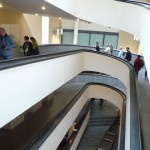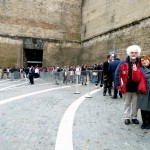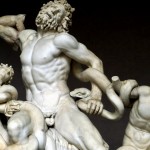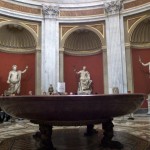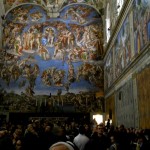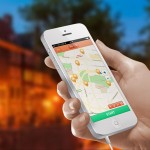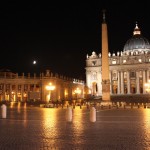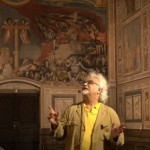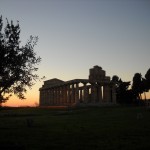Put your headphones on and listen to our travel diaries
Short guide to Vatican Museums
Come with a purpose: what about Sistine Chapel?
When we used to live in Rome, our house was just near Vatican Museums and every day we saw a lot of tourists queueing around the Vatican walls, waiting for their visits. To me -Syusy- the Vatican Museums are the place where the most secret mysteries of our history are hidden. I had been there several times, looking for ancient maps, documents and proofs that could reveal something about historical contradictions and hidden facts. However, this time we want to tell you about a day in Rome as a tourist, introducing you just one of its many faces.
If you want to jump the queue, don’t forget to reserve your visit on the website www.museivaticani.va. We reserved through the Opera Romana Pellegrinaggi, an association that organizes package tours. We paid 26 euro to visit the Museums and San Giovanni, audio guide included. The audio guide is actually very useful: thanks to a system of reference numbers, there is a very simple but interesting explanation for every room. In front of all those artistic treasures, people can find their way among the different centuries, dates and styles.
The Vatican Museums are a binge of beauty, an infinite historical variety. So much that you will feel soon overcome and overstuffed with all that beauty. The audio guide is a good compass and a good pretext to brush on up history.
How to deal with Vatican Museums
At the entrance, we jumped the queue thanks to our web reservation and we arrived straight to the metal detector: you feel like being at the airport, and actually it is like leaving for a long and demanding journey.
The very first feeling is to pass from being just an individual, turning into a big unique tourist flow. This human-whole carries you away. You can easily guess the different nationalities of the groups at a glance: if the guide is waving a little flag, they are from Japan; if he has an umbrella, they are from England; while if the guide is waving something like a shirt or a rag, maybe they are from the East Europe. Anyway, there is no mess, everything goes on.
At Vatican Museums there are so many things that it is impossible “to see” everything. Try to half-close your eyes and let yourself be blinded by only particular things. Let things attract your attention and wake you up from the torpor due to all that beauty!
- Vatican Gardens
- Vatican Museums: main stairs
- Syusy & Pat at Vatican Museums entrance
So many museums
Then we climbed the modern stairs by Giuseppe Momo, where you can enjoy the view of extraordinary scale models of ancient ships. This confirms the theory about Popes as experts on navigation.
The actual route starts here, and here you will finally understand why Vatican Museums use the plural. There are many different museums, each one of them worth a visit. The first one is the Egyptian Museum, but you are immediately at a crossroad: you can continue to the Pigna Court, the Chiaramonti Gallery and the Braccio Nuovo, otherwise to the Clementino Museum and to the Etruscan one.
We were truly moved by some terracotta cylinders with engraving by the Sumerians: the Sumerian tradition hid the secrets about the most ancient history, held the key of the most mysterious knowledge.
But there is no time to stop, beyond the Candelabri Gallery there is the one of the Arazzi, and at last the gallery of the maps. The whole walls are adorned with clear and accurate geographic maps. We saw a fresco by Ignazione and Antonio Danti about Columbus guided to the America by Poseidon in person. Could it be a proof confirming that Columbus was guided to the America by a divine will?
The Sistine Chapel
While walking you will find often shops, or some seats to rest. At the Gallery Pio V, the umpteenth crossroads: we have to choose between the Raphael Rooms and then the Borgia’s Apartment, and the Sistine Chapel. We chose the second option.
In the Vatican Museums everything can be photographed, but the Sistine Chapel… Of course just a few people take pictures of the different rooms, but almost everyone of the Sistine Chapel! First, flash light can ruin the chapel. What is more, it is completely worthless: the Chapel is huge, no picture could ever give the idea of such a masterpiece. Speaking of size: the Sistine Chapel is as big as the Solomon’s temple in Jerusalem.
Don’t you think that Michelangelo had been a great religious innovator? Even a blasphemer: he had been the first who represented God as a human figure. Michelangelo represented our mystic and unconscious world through tangible figures, giving the Catholicism a specific distinctive trait, differently from all the other monotheistic religions in contrast with the representation of God.
Pay a visit to the Sistine Chapel is just like visiting New York: you will feel to have already seen it, on tv, on postcards and pictures, but it is really moving to be there in person. We bought a poster with the whole representation, to brush up on it slowly.
- Vatican Museums: Laocoon and His Sons
- Inside Vatican Museums
- The Sistine Chapel
Be prepared to your next visit
Walking around the Museums, sometimes there is a window or a balcony that looks onto the Vatican Gardens. It is wonderful to realize how beautiful is the context. In the garden, you can also bump into the statue of Laocoön and His Sons by Polidoro, a masterpiece from more than 2000 years ago.
Our daughter Zoe had a school trip to the Vatican Museums just a few months before we came here all together, but it was just like the first time. People can never say “I have already visited the Museums”, because one visit gives nothing but a general impression. During their first visit, people will only figure out the structure of the Museums, not at all the art and history inside. We do not suggest to go necessarely on a second or third visit, but to rather go there with a specific idea, looking for something in particular!
The Vatican Museums are so extended from any point of view, that a general visit would be too superficial: there are 70.000 exhibited pieces and 50.000 other pieces in the warehouses. Every year, almost 5 million people go visit the Vatican Museums, more or less the same number of visitors of Louvre Museum!
Main pic courtesy of Flickr User Renate Flynn

